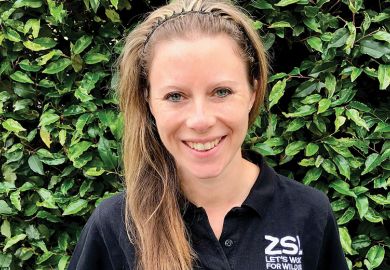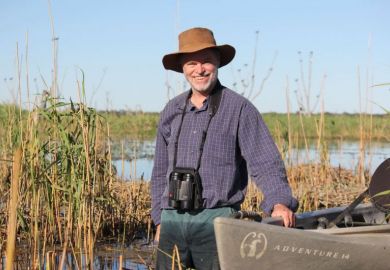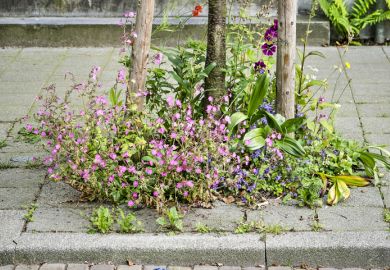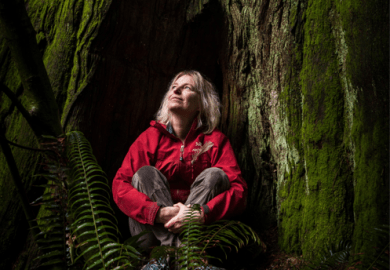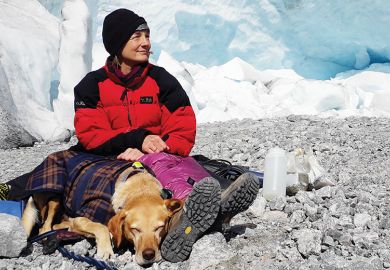Friederike Otto is acting director of the Environmental Change Institute at the University of Oxford. She is one of the pioneers of weather attribution, a new field of climate science that allows researchers to estimate the extent to which individual extreme weather events are caused by man-made climate change. The English translation of her 2019 book explaining weather attribution to the general public, Angry Weather: Heat Waves, Floods, Storms, and the New Science of Climate Change, will be published in September.
When and where were you born?
Kiel, northern Germany, in 1982.
How did your upbringing and family shape you?
My parents were hippies who thought it was very romantic to live in an old farmhouse in the middle of nowhere, so, while I was born in Kiel, I didn’t live there until I was 17. I think the fact that I grew up without any people living nearby shaped me, in so far as I spent a lot of time by myself, reading. My mum’s a teacher, and my dad was a biologist. It’s his fault that I studied physics! I wanted to study history, and he talked me out of it. At that time I was very much interested in the history of philosophy and the history of science, but I couldn’t study history anyway, because my grades were so bad.
You still pursued these interests through a philosophy PhD – how has this shaped your work?
It’s made me much more aware of what science is. One of the main motivations for me to write my book was to explain how science works. I don’t think we are taught it at school – but I think we should be. Only when you understand the scientific process can you understand the difference between a policy brief from an NGO or thinktank, and an academic paper.
Why did you switch back from philosophy to climate physics?
I didn’t switch back, I added physics back in. When you do philosophical research, it’s basically being alone at your desk all week. I wanted to do something that has to do more with the real world, and with people.
How do you calculate the extent to which a particular drought, storm or heatwave is caused by climate change?
We compare today’s possible weather, simulated using various climate models, with possible weather in a simulated world without climate change. If there is a difference in likelihood and intensity of the weather you are interested in, then you can attribute that to man-made climate change.
But you also model our existing climate to work out if a heatwave, for example, is still a freak event, even with climate change.
That’s correct – the first step in our assessment is to find out is whether a weather event, in today’s world with climate change, is a one in 10,000 year event, or a one in two year event. Once you’ve figured that out, you compare with a world without climate change.
Why has weather attribution as a field only emerged over the past decade?
You need powerful computers to repeatedly simulate possible weather events. One reason this field has only emerged recently is that it was, up until 10 years ago, prohibitively expensive. You also need to work out how to do these simulations, and define events that cause loss and damage in the real world. The field needed methodological development, and that’s what I’ve been doing during my career.
How does weather attribution change how scientists can talk publicly about climate change?
Before weather attribution, we could only say: this is a type of event we expect to see more often, but we don’t actually know how much more likely and intense it is due to climate change. But now we do know – and that is powerful.
But the answer is still complex, is that correct?
The result is never just one number. It always depends on how we have defined the event – so in the case of bushfires, for example, you don’t have a bushfire in a climate model. The model only gives you bushfire weather, and there are different ways of calculating fire weather. We never use one model, because some climate models are good at some things, not so good at others, so we use as many models as we can get – you can have eight different models with eight different results. There always is a range. But that is no different to other information for decisions in the future.
What tips do you have for colleagues in other disciplines about how to communicate results?
It pays off if you really invest time with journalists talking through all the details. The next time they write something, they know what you do, they know your number and phone you up to ask you a question, instead of writing something wrong. That is the main thing – working with journalists rather than treating them as some nuisance.
Any other communication tips?
Always write a press release, where you put quotes in, so journalists who are not experts and do not have time to speak to you have something to use that is right. Mostly we write them ourselves, but that’s not ideal, as it’s better if someone outside writes it, then you check it.
Would it have been less anxiety-inducing to have become a historian instead?
For climate change it helps to lessen the anxiety if you are a scientist because you understand the nuances much better, and the likelihoods involved. For example, a lot of people are scared about tipping points and high-impact, low-probability events. They are possible – but they are low probability. Of course, it’s also a personality issue – I don’t do anxiety that much.
What one thing has improved your life as a researcher?
I’ve become much better over the past few years at saying no to stuff I don’t want to do. I don’t work with people I don’t like any more, if it can be avoided – and I’ve discovered it can.
david.matthews@timeshighereducation.com
Appointments
Erika James has been named the next dean of the Wharton School at the University of Pennsylvania. She is currently dean of Goizueta Business School at Emory University in Atlanta and will take up her new position on 1 July, succeeding Geoff Garrett, who is becoming dean of the University of California’s Marshall School of Business. Professor James has also served as senior associate dean for executive education at the University of Virginia’s Darden School of Business. Pennsylvania president Amy Gutmann said Professor James was “a passionate and visible champion of the power of business and business education to positively transform communities locally and nationally”.
Mairi Watson has been appointed pro vice-chancellor (education and student experience) at the University of Hertfordshire. She is currently dean of the faculty of business and law at the University of Northampton, where she has worked since 2012, and before that worked at De Montfort University. “The university’s strategy is a very close fit to my personal values and so I am pleased to have the opportunity to work with everyone to build on recent successes and achieve our aims and ambitions,” Dr Watson said.
Katherine Stanton has been named director of the McGraw Center for Teaching and Learning at Princeton University, after filling the role on an interim basis since July. Previously she served as the centre’s senior associate director for teaching initiatives and programmes for faculty.
Stefanos Polyzoides has been named dean of the School of Architecture at the University of Notre Dame. The award-winning architect, who was on the faculty at the University of Southern California between 1973 and 1996, will join the institution on 1 July.
Leslie Robbins has been appointed dean of the School of Nursing at the University of Texas at El Paso. She has been serving in the role in an interim capacity since September and was previously associate dean of graduate education and professor of nursing.
Register to continue
Why register?
- Registration is free and only takes a moment
- Once registered, you can read 3 articles a month
- Sign up for our newsletter
Subscribe
Or subscribe for unlimited access to:
- Unlimited access to news, views, insights & reviews
- Digital editions
- Digital access to THE’s university and college rankings analysis
Already registered or a current subscriber?



